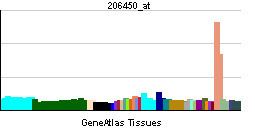EC number 1.14.17.1 | Entrez 1621 | |
 | ||
External IDs MGI: 94864 HomoloGene: 615 GeneCards: DBH | ||
Dopamine beta-hydroxylase (DBH), also known as dopamine beta-monooxygenase, is an enzyme (EC 1.14.17.1) that in humans is encoded by the DBH gene. Dopamine beta-hydroxylase catalyzes the chemical reaction:
Contents
- Mechanism of catalysis
- Substrate specificity
- Clinical significance
- Structure
- Regulation and inhibition
- Inhibitors
- Nomenclature
- References
The three substrates of this enzyme are 3,4-dihydroxyphenethylamine, ascorbate, and O2, whereas its three products are noradrenaline, dehydroascorbate, and H2O.
DBH is a 290 kDa copper-containing oxygenase consisting of four identical subunits, and its activity requires ascorbate as a cofactor.
It is the only enzyme involved in the synthesis of small-molecule neurotransmitters that is membrane-bound, making norepinephrine the only known transmitter synthesized inside vesicles. It is expressed in noradrenergic nerve terminals of the central and peripheral nervous systems, as well as in chromaffin cells of the adrenal medulla.
Mechanism of catalysis
Based on the observations of what happens when there's no substrate, or oxygen, the following steps seem to constitute the hydroxylation reaction.
Although details of DBH mechanism are yet to be confirmed, DBH is homologous to another enzyme, peptidylglycine α-hydroxylating monooxygenase (PHM). Because DBH and PHM share similar structures, it is possible to model DBH mechanism based on what is known about PHM mechanism.
Substrate specificity
Dopamine beta-hydroxylase catalyzes the hydroxylation of not only dopamine but also other phenylethylamine derivatives when available. The minimum requirement seems to be a benzene ring with a two-carbon side chain that terminates in an amino group.
Clinical significance
DBH primarily contributes to catecholamine and trace amine biosynthesis. It also participates in the metabolism of xenobiotics related to these substances; for example, the human DBH enzyme catalyzes the beta-hydroxylation of amphetamine and para-hydroxyamphetamine, producing norephedrine and para-hydroxynorephedrine respectively.
DBH has been implicated as correlating factor in conditions associated with decision making and addictive drugs, e.g., alcoholism and smoking, attention deficit hyperactivity disorder, schizophrenia, and Alzheimer's disease. Inadequate DBH is called dopamine beta hydroxylase deficiency.
Structure
Because it is difficult to obtain a stable crystal of dopamine beta-hydroxylase, its crystal structure is yet to be solved. However, an homology model based on the primary sequence and comparison to PHM is available.
Regulation and inhibition
This protein may use the morpheein model of allosteric regulation.
Inhibitors
DBH is inhibited by disulfiram, tropolone, and, most selectively, by nepicastat.
DBH is reversibly inhibited by l-2H-Phthalazine hydrazone (hydralazine; HYD), 2-1H-pyridinone hydrazone (2-hydrazinopyridine; HP), 2-quinoline-carboxylic acid (QCA), l-isoquinolinecarboxylic acid (IQCA), 2,2'-bi-lH-imidazole (2,2'-biimidazole; BI), and IH-imidazole-4-acetic acid (imidazole-4-acetic acid; IAA). HYD, QCA, and IAA are allosteric competitive.
Nomenclature
The systematic name of this enzyme class is 3,4-dihydroxyphenethylamine, ascorbate:oxygen oxidoreductase (beta-hydroxylating).
Other names in common use include:
